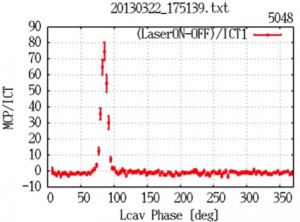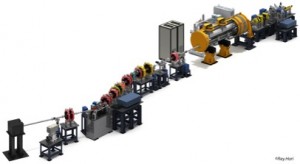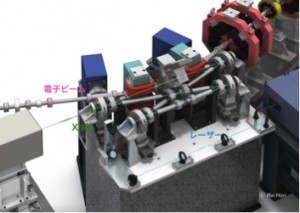
X-ray signal peak at around 80 degrees, captured by MCP (Micro-channel photomultiplier) detector. The MCP signal normalized by beam intensity are plotted as a function of a phase between a laser in the 4-mirror and an electron beam.
On 15 March, scientists working on the Quantum Beam Technology Program at KEK’s superconducting RF test facility (STF) confirmed the successful generation of X-rays using Inverse Compton Scattering (ICS) with superconducting radiofrequency (SCRF) acceleration technology. This is the world’s first successful implementation of ICS X-ray sources with SCRF technology.
The Quantum Beam Technology Program is a 5-year programme supported by the Ministry of Education, Culture, Sports, Science, and Technology. This programme takes advantage of the quantum mechanical nature of the particles, and aims to develop a compact and high-quality particle source for broad and practical applications in medicine, life sciences, information technology, nanotechnology, and quantum science.
The name, Quantum Beam, refers to beams of particles such as neutrons, photons, and ions. “Quantum mechanics has a broad influence on our everyday lives,” said Junji Urakawa, KEK scientist and the project manager for Quantum Beam. For example, without quantum mechanics there would be no transistors, and consequently, no personal computers. In addition, if there were no lasers, which also rely on quantum principles, no DVDs or Blu-ray players would exist. “However, our research is not designed for such purposes, and has not resulted directly in an application for society so far. This programme changed that,” Urakawa said.
When a moving electron collides with a soft photon, the recoiling photon gains energy by transfer from the incoming electron. This process, called inverse Compton scattering (ICS), occurs in many astronomical environments that produce high-energy X-rays or gamma rays. In the Quantum Beam programme, accelerated electrons collide with a laser using a novel technology called four-mirror optical cavity that circulates laser pulses and amplifies its resonance.
ICS is widely recognised as a promising approach to achieve high-intensity high-quality X-rays, which might offer unique capabilities in a wide range of research fields, such as post-genome, nano technology, or structural analysis at the atomic level. Progressive advancements in these research areas will lead to various applications in the industrial, medical, and security-related fields. The practical implementation of ICS sources, however, depends on the ability to achieve high peak brightness of the X-rays. The key technology required to realise this brightness is superconducting RF (SCRF) accelerating technology.

Illustration of the superconducting accelerator (on the right), the beam line for squeezing its transverse size (middle), and the X-ray generation section (on the left) that operates through the collision of the accumulated laser power in the four-mirror optical cavity and using a squeezed electron beam.
SCRF cavities are capable of producing a higher accelerating gradient, meaning they achieve a greater acceleration over the same distance, than other accelerating structures. This means a significant downsizing of the accelerator so that it could fit in an average hospital or laboratory room. These cavities are also more energy efficient, as they conduct electric current with almost no loss of energy.
KEK has made notable contributions to SCRF technology research and development (R&D) for the International Linear Collider. “Accelerators using SCRF have a capability to deliver high-power beams with a huge number of bunches, but at the same time with low charge and keeping its high quality characteristics. The brightness of X-rays from ICS is directly boosted by the collision of a huge number of bunches. This feature will make SCRF ILC technology spread to many applications,” said Hitoshi Hayano, KEK scientist and deputy head for the ILC activities of Linear Collider Collaboration. This successful X-ray generation is an example of a “spin-off effect” of the ILC R&D, even before the realisation of the project.

Illustration of the four-mirror optical cavity with laser axis (blue lines). An electron beam comes in from the right to the left (pink lines), and collides head-on with the laser beam inside of the four-mirror optical cavity. The generated X-rays leave to the left (green line).
The other technology that led to the success is the four-mirror optical cavity. By combining four mirrors to have two optical axes crossing in the centre, a cavity-like structure can be formed in which an injected laser pulse can be stored. This four-mirror optical cavity has a high stability even when its waist size is squeezed to facilitate the collision with an electron beam. When a four-mirror optical cavity is introduced to a head-on collision with an inverse Compton scattering electron, high-brightness X-rays can be generated because of the cavity’s capability of high power laser accumulation with high stability.
This four-mirror technology also has potential for applications. A short pulse and quasi-monochromatic X-ray source has been developed via ICS between a high-quality electron beam and a high-power laser for applications in various areas, such as the medical, biological, and scientific fields. Recently, compact X-ray sources in the range from 0.2 to 70 thousand electronvolts for biological and medical imaging, such as X-ray absorption and refraction contrast angiography, have become very important for our life. Also, since the energy of ICS X-ray is proportional to the square of the electron beam energy, we can realise a tunable source of high brightness monochromatic gamma-ray in the range from approximately 0.5 to several million electronvolts via ICS. Scientists can determine the abundance of difficult-to-identify isotopes in nuclear waste using ICS tunable gamma-ray based on nuclear resonance fluorescence (NRF) measurement for nuclear security.

Very good and informative article.